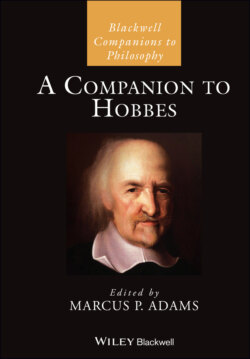Читать книгу A Companion to Hobbes - Группа авторов - Страница 36
2.2 Stoic Roots 2.2.1 Space and Body
ОглавлениеHobbes and the Stoics agree that space and time are infinitely divided and extended, that space has the same dimensions as body, and that time has the successive being of motion. But these structural features are accepted by many philosophers, ancient and modern. I would like to focus on two more controversial ontological questions in Hobbes’s philosophy of space and time: the reality of space independently of body and the reality of time independently of mind. The similar way that Hobbes and the Stoics struggled to meet these philosophical challenges is testimony to the affinity of their systems and Hobbes’s deep Stoic debt.
For Hobbes, our concept of pure space is causally and perceptually derived from body. A person left alone after a “universal annihilation,” remembering the former locations of bodies, would form a “conception of that we call space; an imaginary space indeed, because a mere phantasm, yet that very thing which men call so” (EW I.93). Hobbes is emphatic that whereas the magnitude of body is real, imaginary space is not: “For imaginary space is the effect and magnitude is the cause; this an accident of the mind, that of body existing out of the mind” (OL I.93; EW I.105). Place or locus is likewise merely an abstraction from magnitude: “place is nothing out of the mind, nor magnitude anything within it … place is feigned extension, but magnitude true extension” (OL I.93; EW I.105). So it is not surprising that Hobbes is antagonistic toward ancient (e.g., Lucretian) and modern (e.g., Torricellian) demonstrations of local vacuums (EW I.411–26) and dismissive of void space beyond the world: “there is no real space outside it; but there is no imaginary space either” (Anti-White III.2; 1976, 41).
Hobbes also heaps abuse on Cartesian a priori arguments against the vacuum: “to argue that that there can be no vacuum ‘because vacuum is nothing’ is as cogent as maintaining that ‘no man can fast because to fast is to eat nothing’ … and nothing cannot be eaten” (EW I.109; Cf. Anti-White III.3; 1976, 42). Furthermore, Hobbes affirms that merely imaginary space is sufficient to separate one body from another: “if there intercede any imagined space, which may receive another body, then those bodies are not contiguous” (EW 1.108). He even holds there is real distance in imaginary space: “The ‘distance’ between two bodies, or even between two vacant spaces, is the shortest space lying between them. So if some intermediate part is removed from a continuous body the distance between its extreme parts is not thereby removed” (Anti-White III.3; 1976, 42).
Hobbes’s quasi-realism about imaginary space is highly reminiscent of the Stoics’ conception of pure space as one of the problematic “incorporeals.” As materialists they officially insist that the void is strictly non-existent or “nothing” (Stobaeus; SVF 2.503/LS 49A; 1987, 294). Accordingly, like Hobbes, they make place corporeal: “place is what is occupied by an existent and made equal to what occupies it (by ‘existent’ they mean body)” (Sextus Empiricus; SVF 2.505/LS 49B; 1987, 294). And, like Hobbes, although the Stoics deny the actual existence of local vacua, they do not rule them out a priori. As Galen puts it: “they leave void in the nature of existing things even if they deny its presence within the world” (Galen, SVF 2.503/LS 49E; 1987, 295). There is good reason to think the void extends infinitely beyond the world since it is there capable of receiving body: “it is incorporeal and without contact, neither has shape nor takes on shape, neither is acted upon in any respects nor acts, but is simply capable of receiving body” (Cleomedes, SVF 2 542; LS 49C; 1987, 294). So this “incorporeal” non-existent “subsists” as the possible places of bodies: “void is what can be occupied by an existent but is not occupied, or an interval empty of body, or an interval unoccupied by a body” (Sextus Empiricus; SVF 2.505/LS 49B; 1987, 29). This is just how Hobbes characterized imaginary space: “no man calls it space for being already filled but because it may be filled” (EW I.93).
